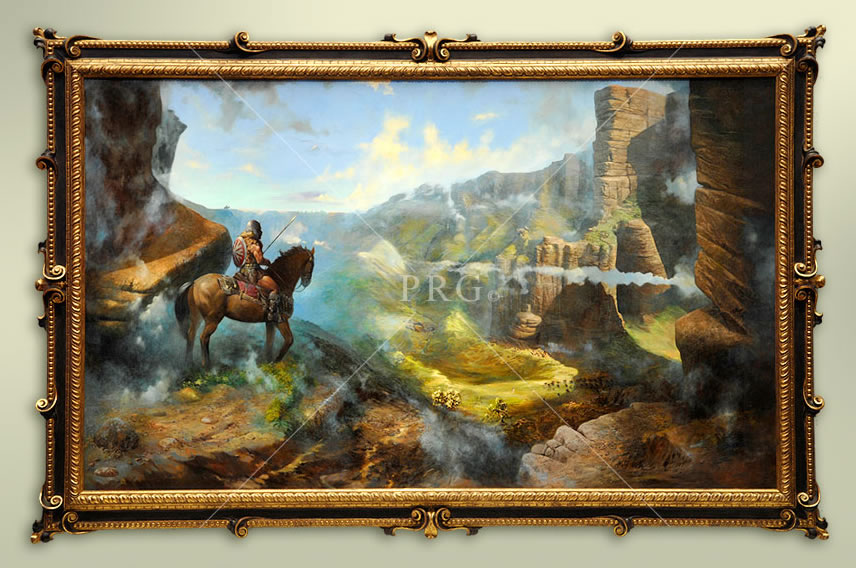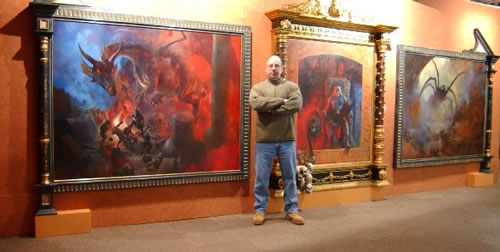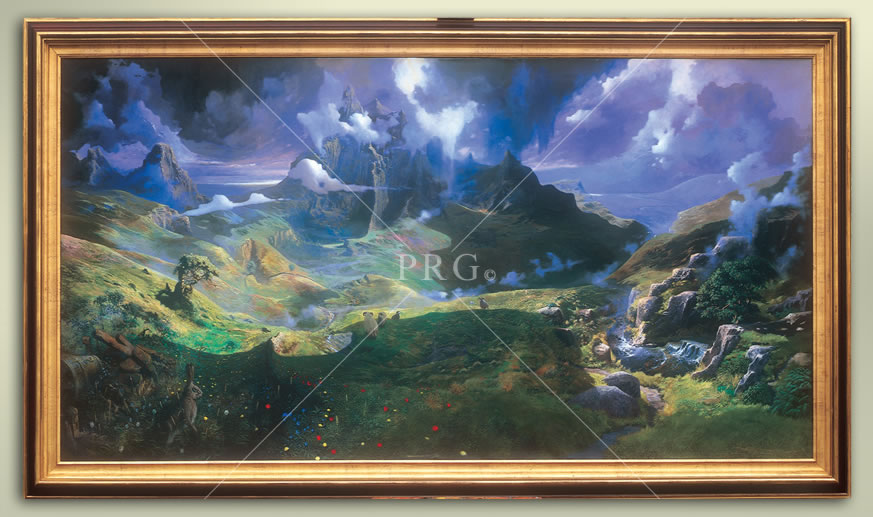Review of Beyond Time and Place - The Art of Paul Raymond Gregory (21.01.13 by Ruth Lacon) -
Comments
I think it is likely that only a few of the oldest Tolkien fans will remember Paul Raymond Gregory as an artist who briefly appeared on the scene back in the late 1970’s and then vanished. It certainly came as a surprise to me that he had been working on tolkien-inspired art ever since, alongside his main career as an album-cover artist and music promoter. The result is the collection of paintings which form part of this book.
In the section on Tolkien, only one piece has as far as I know ever been widely published before, the first one, ‘The Ride of the Rohirrim’. The rest is an undiscovered treasure-trove by a remarkable artist. It is true that a great deal may seem familiar somehow, but Gregory is one of the founding fathers of fantasy and heavy-metal art. His influence has become widespread, but these works consistently pre-date the use of similar styles by other artists. And, I have to say, few of the others working in this sort of style do it anything like as well.
Gregory’s work is showcased by the stunning production values of this book. The reproductions are simply magnificent, including a fair number of images which are enlargements allowing full appreciation of a piece, and unusual shots of a painting in its frame. Gregory has been fortunate enough to work with a craftsman framer of the highest quality, and the book’s ample presentation allows us to see how painted picture and carved frame work together to create a single artistic whole of unusual impact.
Gregory’s use of oil-paint as a medium also attaches him to a long tradition of mythic, literary and legendary subjects, reaching far beyond the modern genre of ‘fantasy art’.
We are rather used to judging a Tolkien artist by their adherence to the text, and on that standard, it is true, Paul Raymond Gregory’s work will often be controversial. He is often not an accurate painter. However, it seems to me that like many 19th-century artists, he is more interested in producing good art than in sticking to the letter of the text. There are points on which his interpretation is widely at variance with the usual ones, but to my mind, that is anything but a fault. It is good to see different ideas, especially now when we are suffering from an overdominance of the film imagery. Whether you like the result or not has to be a personal judgement; my own opinion varies too widely to be shortly stated.
I think that Gregory is particularly fine as a landscape painter, in a style which demands comparison to the American 19th-century ‘Hudson River School’. This is not the crystalline, classical world of Albert Bierstadt or in our own time, Ted Nasmith. Rather, it is the turbulent, evocative and emotive landscape of Thomas Moran and the British painter John Martin. (Moran’s ‘Hiawatha’ pictures are particularly relevant as comparison). Using this style, Gregory gets away with much that in a lesser artist might be considered flaws. ‘The Source of the Anduin’, for instance, manages to flow seamlessly back from a foreground detailed in an almost Pre-Raphaelite manner, to a broad-brushed distant landscape in which bubble-bath clouds contrive to look entirely right. Gregory’s figurework is somewhat variable, but when it is good it fits its place well, suiting the style of the overall piece. He is hardly the only Tolkien artist to have problems with this most awkward of areas – and technically excellent figurework carefully studied from the model does not necessarily a good picture make, as the Hildebrandt Brothers’s art warns us.
The considerable body of non-tolkien work featured in this book – 100 pages out of 176 – relates to the world of heavy-metal music, but it will be of interest to more than just fans of the genre. It is very valuable for comparison and contrast, giving us an unusually well-rounded view of Paul Raymond Gregory as an artist. At times, it shows off facets of Gregory’s art which have not (yet?) appeared in his tolkien-inspired paintings, such as the wicked humour of the mouse gleefully controlling a huge snakey monster in one of his pieces from the Bloodstock festival. The text mostly forms a discreet accompaniment to the paintings, explicating as much as is necessary to assist our understanding and enjoyment. There are a number of contributions by musicians which explain the circumstances of certain non-tolkien works’ creation, and also a mini-essay on the fascinating business of the frames.
There is undoubtedly much here that many people will not like. Gregory’s interest in emotion and in action means that much of his tolkien-inspired work is more Sublime than Beautiful, more awe-inspiring and heartshaking than likeable. Even light and brightly coloured pieces are not just ‘pretty pictures’. Also, as I have said, the book contains both Tolkien and non-tolkien art, with the latter in the majority, and from an area with which some people may have little sympathy. For the numerous people with interests in both Tolkien and heavy metal or hard rock music, however, that will make this book particularly intriguing. The British Tolkien Society’s magazine Amon Hen has reviewed orc-rock albums from Scandinavian fandom in the past, and that is certainly one group who would find this book of interest. More generally, this is our first look at a large body of practically unknown art inspired by the works of JRR Tolkien, and many of the pieces are on rare or unique subjects. Whether you like Gregory’s art or loathe it, for the serious student of art Inspired by the writings of JRR Tolkien this is an important book. It is also quite simply an unusually beautiful artefact in and of itself; even the regular edition is a splendid thing to hold, and the Special Edition is a truly remarkable piece of work.
I should say here that although my husband Alex Lewis was one of the contributors, I myself had no part in the making of this book. Nor had I done more than glance casually at Paul Raymond Gregory’s website before being asked to write this review. My opinions are my own.
Authors: Greg Moffitt and Alex Lewis
Publisher: Studio 54 Publications
Publication Date: 10 Oct 2012
Type: hardcover, 176 pages
ISBN-10: 0957309503
ISBN-13: 978-0957309500
Hardcover and Limited edition available at studio54.co.uk
Spread the news about this J.R.R. Tolkien article:


